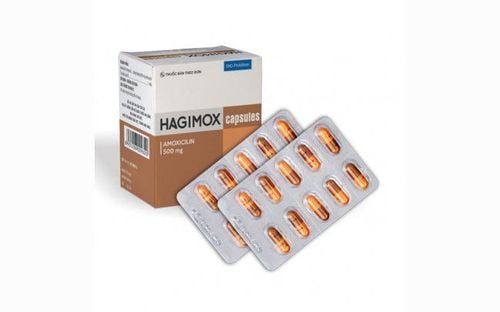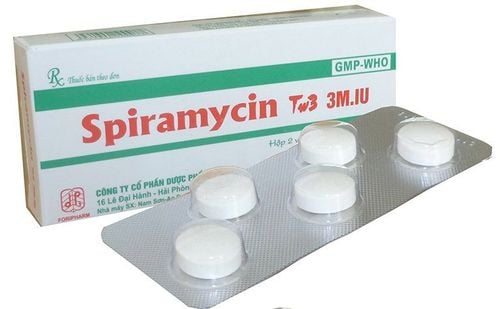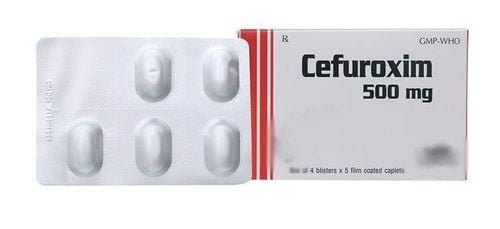This is an automatically translated article.
Hagimox is a prescription drug containing the active ingredient Amoxicillin, an antibiotic of the Penicillin group. The drug is indicated in cases of bacterial infections caused by pneumococcal, streptococci, staphylococcus, upper respiratory tract and urinary tract infections... Let's learn about the dosage and the notes when using Hagimox through the article. write the following.
1. What disease does Hagimox treat?
1.1. Indications for use of Hagimox Hagimox contains the active ingredient Amoxicillin - an antibiotic of the Penicillin group, which is prepared in two popular strengths, 250mg and 500mg. Hagimox is indicated in the treatment of the following infections:
Upper and lower respiratory tract infections caused by pneumococcal, streptococci, staphylococci that do not secrete H.influenzae and penicillinase; Biliary tract infections, gonorrhea; Skin and soft tissue infections caused by staphylococcus, streptococcus and E. coli sensitive to amoxicillin. 1.2. Pharmacodynamics Amoxicillin is an antibiotic Aminopenicillin has a broader spectrum of activity than Benzylpenicillin (including gram-negative bacilli), and is stable in acidic media. The mechanism of action of Amoxicillin is bactericidal by inhibiting the biosynthesis of mucopeptides of the bacterial cell wall.
The antibacterial activity of amoxicillin includes both gram-negative and gram-positive bacteria such as staphylococcus, non-penicillinase-producing streptococci, Diplococcus pneumoniae, H.influenzae, E.coli and Proteus mirabilis. Amoxicillin is inactive against penicillinase-producing bacteria, especially methicillin-resistant staphylococcus, strains of Pseudomonas, Klebsiella and Enterobacter.
The antibacterial activity of Amoxicillin in vitro is stronger than that of ampicillin on Salmonella spp., Enterococcus faecalis, but less against Shigella spp.. In addition, the spectrum of action of Amoxicillin is broader when combined with clavulanic acid. and sulbactam. However, there have been reports of E.coli resistance to the combination of Amoxicillin and clavulanic acid.
1.3. Pharmacokinetics Amoxicillin is a stable antibiotic in the acidic environment of the stomach. Absorption occurs rapidly, completely from the gastrointestinal tract and is not affected by food. After absorption, Amoxicillin is rapidly distributed into body fluids and tissues, with the exception of cerebrospinal fluid and brain tissue. However, when the meninges are inflamed, diffusion of Amoxicillin into the cerebrospinal fluid occurs readily. The half-life (t1/2) is about 61.3 minutes and may be longer in neonates and the elderly. In patients with renal insufficiency, the half-life of amoxicillin ranges from 7 to 20 hours.
Elimination of the drug occurs via the kidneys and faeces. Of these, about 60% of a dose of amoxicillin is excreted in the urine in 6-8 hours. High concentrations of the drug are found in bile and are partially eliminated in the feces. Probenecid prolongs the renal elimination of the drug.

Thuốc Hagimox được sử dụng trong các tình trạng nhiễm khuẩn
2. Dosage and how to use Hagimox
Hagimox is prepared in two popular strengths, 250mg and 500mg. So, besides the question of "what does hagimox 250mg do?" Or “what does hagimox 500mg do?” Dosage and administration also play an important role. Accordingly, Hagimox can be taken before and after meals. Dosage depends on the age and medical condition of the patient. Specifically as follows:
Adults and children > 10 years old: Take 500mg x 3 times/day; Children from 5 to 10 years old: Take 250mg x 3 times/day. For higher doses, take a single dose or in short courses; For the dose of Hagimox 3g, it is repeated after 8 hours to treat periodontal abscess or repeated after 10-12 hours to treat uncomplicated acute urinary tract infections; A single dose of Hagimox 3g taken 1 hour before procedures such as tooth extraction has the effect of preventing endocarditis in people at high risk; High dose regimen Hagimox 3g used twice a day in patients with severe respiratory infections or recurrent infections; In some necessary cases, children from 3 to 10 years old with otitis media can take a dose of Amoxicillin 750mg/time x 2 times/day for 2 days; For patients with renal failure, the dose of Hagimox is as follows: 500mg/24 hours in patients with creatinine clearance (Cl) < 10 ml/min; 500 mg/12 hours in patients with creatinine clearance (Cl) > 10 ml/min.
3. Note when using Hagimox medicine
3.1. Contraindications Contraindicated to use Hagimox in cases where the patient is allergic to any penicillin antibiotic.
3.2. Caution when using the drug Patients should note a number of problems when taking the drug as follows:
Periodically check kidney and liver function during long-term treatment with the drug; Patients may develop severe hypersensitivity reactions in case of a history of allergy to penicillin or some other allergen. Therefore, it is necessary to carefully investigate the history of allergy to Cephalosporins and Penicillins; In the event of allergic reactions such as Quincke's edema, erythema, Stevens-Johnson syndrome, anaphylaxis, the patient should immediately discontinue amoxicillin therapy, administer emergency oxygen, ventilation and therapy. Intravenous corticosteroids, including endotracheal intubation, and penicillin or cephalosporin antibiotics should not be used in future treatment.

Thuốc Hagimox cần được dùng theo đúng hướng dẫn của bác sĩ chuyên khoa
4. Effects of drugs on special subjects
Can Hagimox be used for babies, pregnant women and lactating women? Accordingly, the effects of the drug on special subjects are as follows:
Pregnant women: There are no studies on the absolute safety of amoxicillin for pregnant women. Therefore, only use drugs when absolutely necessary; Lactation: The drug is excreted in breast milk, so it may cause adverse effects on the baby. Therefore, caution should be exercised when using Amoxcillin in lactating women; Machine Operators: The drug is unlikely to have an adverse effect on the ability to drive or use machines.
5. Drug interactions
Some possible drug interactions are as follows:
Use in combination with Nifedipine increases the absorption of Amoxicillin; Use in combination with Allopurinol increases the likelihood of rash of Amoxicillin; The drug probenecid reduces the excretion of Amoxicillin in the renal tubules, increases the concentration of the drug in the blood causing toxicity; There may be antagonism between Amoxicillin and bacteriostatic agents such as Tetracycline, Chloramphenicol. Above is the information you need to know about the drug Hagimox. Hopefully, before using this drug, you have understood the uses and methods of use to ensure safety and maximize the effectiveness of the drug.













